Roasting coffee, The different fases and the development of the coffee bean

Here at Café du Jour we have a large selection of fresh roasted coffee. The taste of the coffee is mostly decided by the roasting profile: the speed of the roasting in the different fases and the point we take the coffee beans out of the roaster. But what fases does the coffee bean go through during the roasting?
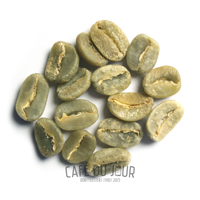
Unroasted Coffee beans, like the ones we receive
The unburned coffee beans (actually the coffee berry without the skin) arrives here from the country where the coffee was produced. Most of our coffee beans come into Europe through the port of Antwerp and arrive in jute bags from around 70KG a piece. one bag gives us around 57KG of roasted coffee beans in the end. This is because during the roasting process the beans lose between 18% and 22% of their weight to loss of moisture.
These green beans are very tough, smell a bit like grass and are very compact.
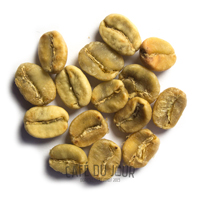
The drying fase, most of the moisture evaporates
In this fase we warm up the beans. We see a distinct difference between warming up and heating up the beans. This is because the beans cannot be heated up in this fase. The maximum temperature for the beans is about 150℃. The drying fase takes about 4 to 8 minutes and makes sure the beans get nice and dry. There is no taste development yet, thats for another fase.
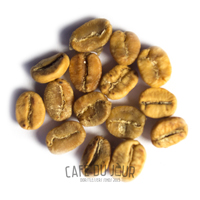
The 'yellow' fase: coffee beans that smell like hay.
This fase mark the beginning of the real roasting process: a "maillard response" takes place. This means that a complex turn of reactions occur between reducing sugars and amino acids under the influence of heat. These reactions makes it possible for the coffee to change colour. Eventhough the drying fase happens before this fase, not all the moisture is out of the beans. the drying fase continues through this fase.
During this fase the coffee smells a bit like rice and hay. The hot air coming from the roaster is more steam than smoke.
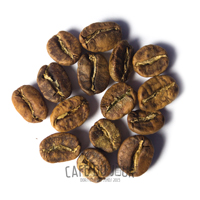
The 'yellow/brown' fase: the smell of baked bread
We are now on the end of the preparation process of the real development fase. The coffee is now starting to smell like baked bread. We use this precise moment to moderate the temperature in the coffee roaster so we don't move to fast in the following fases. The ratio ventilation and heat in the roaster is now being optimalized by the master roaster. Depending on the type of coffee this ratio can be different everytime. From now on there is less moisture escaping the air and smoke needs to be constantly deducted.
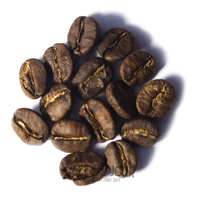
The 'first crack': the taste development at its finest
During the drying fase and yellow/brown fase the coffee beans turn exothermic and the coffee wil enter its first 'crack'. During the drying fase and the browining fase the coffee beans have collected energy that makes the bean explode. Of course the beans are very small and the explosions are very little. Because there are hundred thousand beans in the roaster at once (one cup of coffee is about 70-80 coffee beans) this creates cracking noises. Thats why we call it the first crack, its the start of the development fase and the taste development for the coffee.
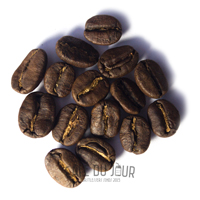
The development fase: light till medium
Some blends and origin coffee's are taken out of the roaster in the same fase
The development fase is now fully in progress. Depending on the roasting profile that we want and the coffee we want to make its time to decide when we will take the coffee beans out of the roaster. The development fase of light/medium roasted beans is normally around 15%-20% of the total roasting time. In this fase the coffee is a a bit more fruity and more sour than bitter. Coffee that is taken out of the roaster in this fase has a distinct taste of it's own. This makes it easier to see the difference between different types of beans.
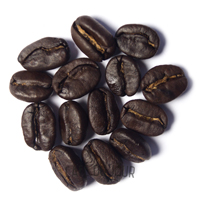
The development fase: medium till dark (the second crack)
Typical espresso coffee's are taken out in this fase
Coffee that is roasted longer is more bitter. For example most Italian brands are roasted longer than most coffee's. The longer we roast the coffee the stronger the bitter taste will be. The burning profile/ the speed that we are aiming for is crucial in this fase because it decides the taste. Generally the coffee that we call 'espresso' is usually roasted a little slower but to the dark point. This makes it lose the fruity and sour flavor. Caffè crema is a coffee we want to keep a little more fruity. This is why we roast it quicker with more heat. This of course is different per coffee bean. This is why inventing a coffee is trail and error, adjusting and adapting. During this fase the coffee 'cracks' for the second time.
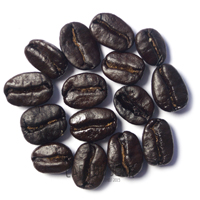
The extremely dark fase
We rarely roast beans to this point unless the costumer asks us to roast to a specific dark coffee bean
This coffee is usually not sold in supermarkets, even a package of 'dark roast' coffee is roasted lighter than these beans. The reason for this is that fully automatic coffee machines are not able to handle the dark coffee. The dark coffee is very greasy on the surface, this can create cloggin in the machine and that can cause damage. We roast these beans only on request.
Which coffee roast, and making your own coffee roast
We can make the coffee exactly to your liking (starting from 2KG), you can make the specification yourself on the coffee beans and making your own roast page. Furthermore is our assortement never burned more than four weeks ago when we ship it. We also sell unroasted beans for the coffee lovers who wants to experiment roasting the beans themselves. Even when you want to go a little more professional Cafe du jour sells coffee roaster for at home use.
Video of the coffee roastry
To give you an impression of the process of roasting coffee, we made a video of our coffee roastry.












